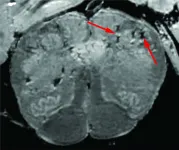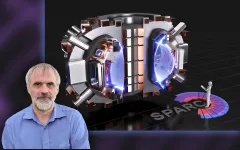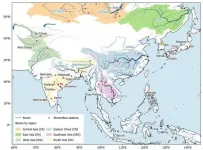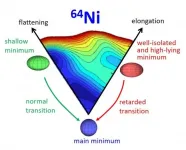Imaging of ballistic wounds, bullet composition and implications for MRI safety
Since patients with ballistic embedded fragments are frequently denied MRI, due to indeterminate bullet composition sans shell casings, radiography and CT can be used to identify nonferromagnetic projectiles that are safe for MRI
2021-01-02
(Press-News.org) Leesburg, VA, December 29, 2020--According to an article in ARRS' American Journal of Roentgenology (AJR), because patients with ballistic embedded fragments are frequently denied MRI (due to indeterminate bullet composition sans shell casings), radiography and CT can be used to identify nonferromagnetic projectiles that are safe for MRI.
"Commercially available handgun and shotgun ammunition representing projectiles commonly encountered in a clinical setting was fired into ballistic gelatin as a surrogate for human tissue," explained first author Arthur J. Fountain from the department of radiology and imaging sciences at Emory University.
After obtaining radiographs and CT images of these gelatin blocks, Fountain and colleagues then obtained MR images of unfired bullets suspended in gelatin blocks using T1- and T2-weighted sequences. Magnetic attractive force, rotational torque, and heating effects of unfired bullets were assessed at 1.5 T.
Based upon debris trail and primary projectile deformation, the team separated the fired bullets into two groups: ferromagnetic and nonferromagnetic. Although ferromagnetic bullets showed mild torque forces and marked imaging artifacts at 1.5 T, nonferromagnetic bullets did not exhibit these effects.
Importantly, heating above the Food and Drug Administration limit of 2°C was not observed in any of the projectiles tested.
Additionally, the authors of this AJR article presented a triage algorithm for patients with retained ballistic fragments. "In particular," Fountain et al. described, "a projectile that leaves a metallic debris trail from entry to final position or has been appreciably deformed is of copper, copper-alloy, or lead composition with a partial jacketed configuration or represents lead shotgun shot and does not pose a significant risk for imaging at 1.5 T or less, regardless of when the injury occurred."
"Nonferromagnetic ballistic projectiles do not undergo movement or heating during MRI, and the imaging modality can be performed when medically necessary without undue risk and with limited artifact susceptibility on the resulting images, even when the projectile is in or near a vital structure," the authors concluded.
INFORMATION:
Founded in 1900, the American Roentgen Ray Society (ARRS) is the first and oldest radiological society in North America, dedicated to the advancement of medicine through the profession of radiology and its allied sciences. An international forum for progress in medical imaging since the discovery of the x-ray, ARRS maintains its mission of improving health through a community committed to advancing knowledge and skills with an annual scientific meeting, monthly publication of the peer-reviewed American Journal of Roentgenology (AJR), quarterly issues of InPractice magazine, AJR Live Webinars and Podcasts, topical symposia, print and online educational materials, as well as awarding scholarships via The Roentgen Fund®.
[Attachments] See images for this press release:
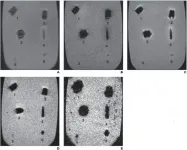
ELSE PRESS RELEASES FROM THIS DATE:
2021-01-02
While the world has its eyes on vaccines to stop the spread of coronavirus, therapeutics are still necessary to treat hospitalized patients. One of these treatments, remdesivir, is the first and only antiviral agent of its kind that the U.S. Food and Drug Administration (FDA) has approved so far for COVID-19.
Research at the University of Cincinnati, however, contends that this antiviral drug is being used too indiscriminately when treating patients hospitalized with the virus. The study is published in the journal Fundamental & Clinical Pharmacology.
The FDA approved remdesivir, marketed as Veklury, for emergency use authorization in May 2020 to treat COVID-19 and granted full approval ...
2021-01-02
Mobile apps have revolutionised the way people meet in Switzerland and elsewhere in recent years. Unlike traditional dating sites, these apps do not feature detailed user profiles but are largely based on rating photos using a swipe review system. As dating apps escalated in popularity, so has criticism about them encouraging casual dating only, threatening the existence of long-term commitment, and possibly damaging the quality of intimacy. There is no scientific evidence, however, to validate these claims. A study by the University of Geneva (UNIGE), Switzerland, provides a wealth of information about couples who met through dating apps, drawing on data from a 2018 Swiss survey. The results, ...
2021-01-02
Very low birthweight infants often need blood transfusions to survive. A National Institutes of Health-funded study suggests that providing a higher threshold of red cells within accepted limits offers no advantage in survival or reduction in neurological impairment over a lower threshold. The research was conducted by Haresh Kirpalani, B.M., of the University of Pennsylvania, Philadelphia, and colleagues and was funded by the NIH's Eunice Kennedy Shriver National Institute of Child Health and Human Development (NICHD), National Heart, Lung, and Blood Institute, and National Center for Advancing Translational Sciences. The study appears in The ...
2021-01-02
Women awaiting liver transplants in the United States are known to be about one-third more likely than men to become too ill to undergo surgery or die before receiving a liver. Now a study headed by UC San Francisco and Columbia University highlights the role that frailty plays in this gender gap.
The study followed 1,405 patients with cirrhosis, of whom 41 percent were women, awaiting liver transplantation at nine transplant centers in the United States. The men, whose ages ranged from 49 to 63, were more likely to have chronic hepatitis C and alcoholic liver disease (27 percent versus 22, and 33 percent versus 19 percent). The women, whose ages ranged ...
2021-01-02
In an in-depth study of how COVID-19 affects a patient's brain, National Institutes of Health researchers consistently spotted hallmarks of damage caused by thinning and leaky brain blood vessels in tissue samples from patients who died shortly after contracting the disease. In addition, they saw no signs of SARS-CoV-2 in the tissue samples, suggesting the damage was not caused by a direct viral attack on the brain. The results were published as a correspondence in the New England Journal of Medicine.
"We found that the brains of patients who contract infection from SARS-CoV-2 may be susceptible to microvascular blood vessel damage. Our results ...
2021-01-02
The U.S. Department of Energy's (DOE) Princeton Plasma Physics Laboratory (PPPL) is collaborating with private industry on cutting-edge fusion research aimed at achieving commercial fusion energy. This work, enabled through a public-private DOE grant program, supports efforts to develop high-performance fusion grade plasmas. In one such project PPPL is working in coordination with MIT's Plasma Science and Fusion Center (PSFC) and Commonwealth Fusion Systems, a start-up spun out of MIT that is developing ...
2021-01-02
In a first-of-its-kind study within cycad horticulture literature, University of Guam researchers have found that the use of anti-transpirants neither help nor hinder successful propagation of cycad stem cuttings.
The Guam-based study, published Oct. 22 in the journal Tropical Conservation Science, investigated whether retaining leaves during the propagation of cycad stem cuttings conferred any benefit to propagation success. Additionally, two anti-transpirant products were utilized to investigate their efficacy during the propagation process.
Leaves perform a variety of critical functions for plants, including ...
2021-01-02
813 years of annual river discharge at 62 stations, 41 rivers in 16 countries, from 1200 to 2012. That is what researchers at the Singapore University of Technology and Design (SUTD) produced after two years of research in order to better understand past climate patterns of the Asian Monsoon region.
Home to many populous river basins, including ten of the world's biggest rivers (Figure 1), the Asian Monsoon region provides water, energy, and food for more than three billion people. This makes it crucial for us to understand past climate patterns so that we can better predict long term changes in ...
2021-01-02
COLUMBUS, Ohio - The introduction of computer simulation to the identification of symptoms in children with attention deficit/hyperactivity disorder (ADHD) has potential to provide an additional objective tool to gauge the presence and severity of behavioral problems, Ohio State University researchers suggest in a new publication.
Most mental health disorders are diagnosed and treated based on clinical interviews and questionnaires - and, for about a century, data from cognitive tests has been ...
2021-01-02
Kraków, 30 December 2020
The map of nuclear deformation takes the form of a mountain landscape
Until recently, scientists believed that only very massive nuclei could have excited zero-spin states of increased stability with a significantly deformed shape. Meanwhile, an international team of researchers from Romania, France, Italy, the USA and Poland showed in their latest article that such states also exist in much lighter nickel nuclei. Positive verification of the theoretical model used in these experiments allows describing the properties of nuclei unavailable in Earth laboratories.
More than ...
LAST 30 PRESS RELEASES:
[Press-News.org] Imaging of ballistic wounds, bullet composition and implications for MRI safety
Since patients with ballistic embedded fragments are frequently denied MRI, due to indeterminate bullet composition sans shell casings, radiography and CT can be used to identify nonferromagnetic projectiles that are safe for MRI


